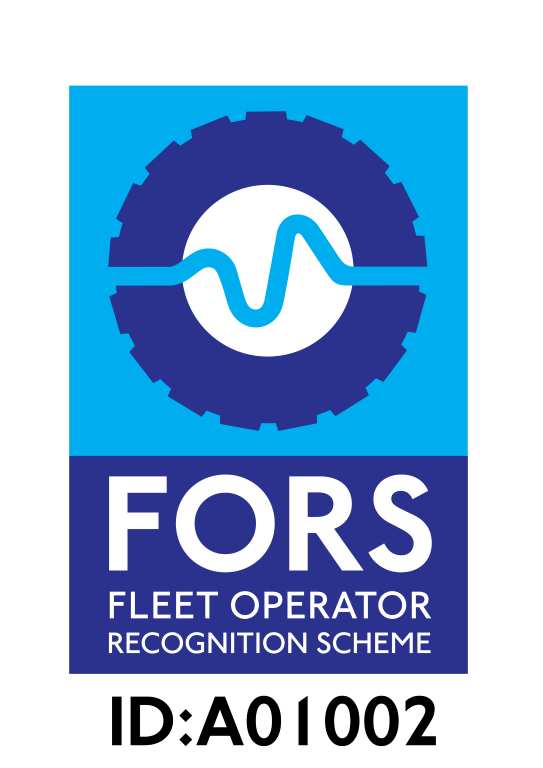Ghostbusters 1984 – 1959 Cadillac Miller-Meteor
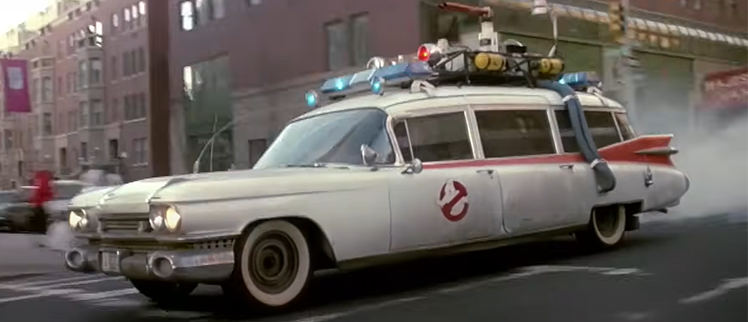
When you and your gang of ghost hunting nerds need a practical ride to carry your unlicensed nuclear accelerators, what comes to mind? Obviously a 1959 Cadillac Miller-Meteor ambulance conversion. Known as the Ecto-1, the Cadillac becomes its own character as the team give it a makeover, rendering it unrecognizable from the original, with sirens and pseudoscience contraptions on the roof. The Ecto-1 is just as quirky and personable as the team, and has cemented itself as a cinematic icon with countless adoring fans.
When Ghostbusters, directed by Ivan Reitman and written by Dan Aykroyd, Harold Ramis and Rick Moranis, was released it was met with instant success.It was the number-one film in theatres for seven consecutive weeks and grossed over $100 million. It remained to be the highest grossing comedy until the title was taken in 1990 by Home Alone. It’s easy to see why, from well written and constant humour, to a storyline that resonates and a theme that can be enjoyed by adults and children alike.
The film follows a group of mismatched scientists who delve into the world of the supernatural, under the team name the ‘Ghostbusters’. The Ghostbusters operate from an old firehouse and are called to rid New York of paranormal threats, for a price. Their adventures are wacky and zany, but the stakes are still high, especially in the finale where all hell breaks loose and a certain marshmallow man makes an appearance. The film is fun and demonstrates impressive special and practical effects for the time period.
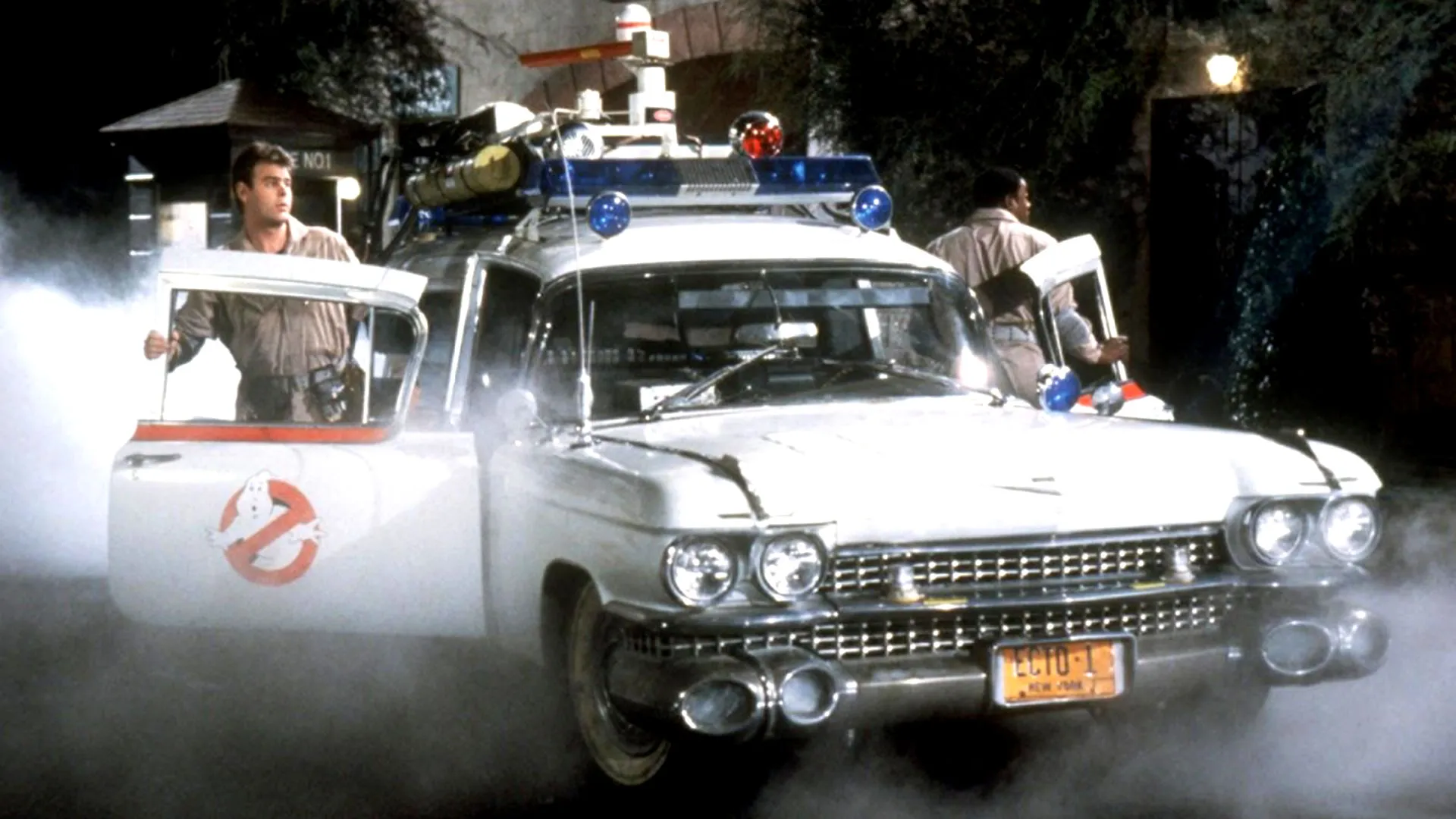
The Ecto-1, as previously mentioned is a 1959 Cadillac Miller-Meteor ambulance conversion, but this may be your first time hearing about it, so what is it and why did it look that way in the movie?
Back when the film was in production, Cadillac worked differently than they do today. While you could buy models that were ready-made, the Miller-Meteor was what was known as a ‘coachbuilt’ vehicle. Cadillac would build the chassis, the engine and most of the mechanical components and then a third party would complete the body and interior. Miller-Meteor was a third-party company that would take these Cadillacs and convert them into professional-use vehicles or other American companies. These included hearses, limos and ambulances – the latter being what the Ecto-1 started life as.
The swoopy 50s design philosophy was on full display on this ~7000lbs (3175kg) hunk of solid steel, V8 fitted beast. The flamboyant curves and chrome accents made the Ecto-1 stand out on screen, and the iconic white and red paintjob matches the ghostbusters logo and stands out in the nighttime scenes. Originally, the Ecto-1 was meant to be painted black, but this didn’t look as effective on camera, so we ended up with what we know and love, and I’m so glad we did.
Halloween 1978 – Ford LTD Station Wagon and 1977 BMW 320i (E21)
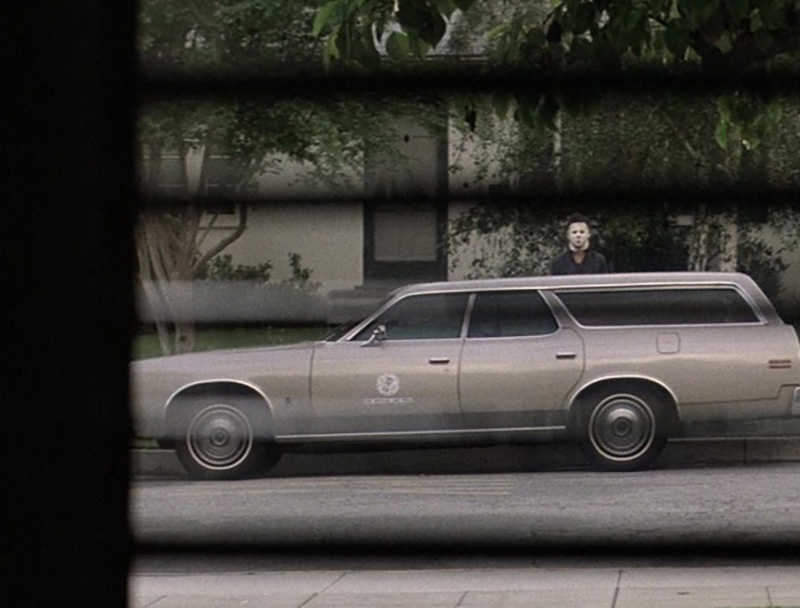
Halloween is a classic 70s slasher that grew in infamy over the years and helped define the horror sub-genre we’ve grown to love and fear. Halloween is an independent slasher directed and scored by John Carpenter and acts as Jamie Lee Curtis’ debut film in which she plays babysitter Laurie Strode. The film follows mental patient Michael Myers after he escapes from Smith's Grove Sanitarium, locked away for murdering his sister when he was six. Fifteen years later, he’s out and stalking our protagonist and final girl, Laurie, while on a killing spree of Haddonfield’s teenage babysitters, all while perused by his psychiatrist, Dr Loomis.
Halloween was received incredibly well, grossing over $70 million worldwide. On a budget of $300,000 - $325,000, it is one of the most profitable independent films of all time. Spawning a huge franchise that would contain 13 movies of varying qualities, all of which (but Halloween 3 due to Carpenter originally planning on making Halloween an anthology series) featuring the embodiment of pure evil in that infamous William Shatner mask, accompanied by Carpenter’s bone-chilling piano score. The Halloween franchise would go on to explode with popularity, branch out and cross over into other IPs.
Michael escapes from Smith's Grove while being transferred to court on Halloween night. He steals a Ford LTD Station Wagon, property of the State of Illinois and uses it to return to Haddonfield to satisfy his long-starved bloodlust. I don’t know what’s more impressive, Michael knowing his way back to his hometown, or knowing how to drive despite being locked away since the age of 6. The station wagon is seen in several iconic moments in the film, such as Michael standing eerily behind it as he stalks Laurie, only to disappear at a second glance.
A bit of interesting movie trivia here, in a scene with Dr Loomis in the centre frame, Michael is seen pulling out at a junction behind him, checking both ways before making his manoeuvre. Despite being a serial killer, he still respects the rules of the road.
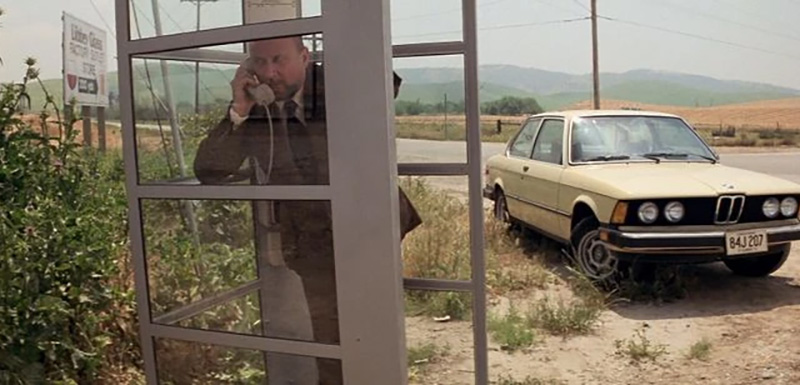
Speaking of Dr Loomis, he drives a car worthy of mention - a 1977 BMW 320i (e21). The E21 was the first generation of the BMW 3 Series and was produced from June 1975 to December 1983, replacing the 02 Series. The compact executive cars were produced with carburetted four-cylinder engines of 1.6L, 1.8L and 2.0L. The 320i made around 123hp and had a stop speed of 113mph, not that Dr Loomis would need all of that power to catch Myers, who is never seen exceeding a walking pace. Nonetheless, the 320i is an iconic car, but unlike the Ecto-1 from Ghostbusters, the E21 is not remembered for its role in the film, but because it was simply a good car.
The 320 saw some action in motorsports, starring in Group 5 in 1977, replacing the BMW 3.0 CSL and earning the name the ‘Flying Brick’ due to its blocky body shape. It was powered by a Formula Two engine, tuned to make 302bhp. The 320 won its first race at Zolder in 1977 and also won the 1981 and 1982 Guia Race of Macau.
Christine 1983 – 1958 Plymouth Fury

She'll possess you. Then destroy you. She's death on wheels.
Christine, written by Steven King and Bill Phillips and directed by John Carpenter, is a supernatural horror/thriller in which the antagonist is a 1958 Plymouth Fury, possessed by evil spirits. Not your typical villain in these types of movies, but Christine really does put the ‘fury’ into Plymouth Fury. Christine follows outcast Arnie Cunningham as he transforms subtly from a wimpy high school nerd to a cocky, unlikeable teenager, almost adopting an alter-ego as he restores the bright red Plymouth. As the restoration of Christine progresses, Arnie loses touch with reality more and more, alienating himself from the few friends he had due to the obsession he had with his new car. Arnie loves the Plymouth, and the Plymouth loves Arnie, though it harbours a dark secret past.
The Plymouth was involved in two accidents, one of them fatal, whilst still on the assembly line. There are many unknowns as to why the car was possessed (since the book and film are quite different), but the leading theory is that the spirit of the car's previous owner possesses it after having an unhealthy relationship with the car, much like Arnie. The car itself had power over both characters, manipulating them. The film explores themes and questions why people have an unhealthy obsession with their cars and is having an obsession worth the problems and dynamics that come with it? Personally, I’m obsessed with my Astra, but I feel fine!
Christine received generally positive reviews, grossing $21 million at the box office and becoming a cult classic and garnering a following of people who either resonate with the film's themes or simply enjoy the genre. Look online and you will find countless forums of people discussing what exactly made Christine evil, which I personally believe is a strong trait of the film - being able to hold people’s attention all these years later.
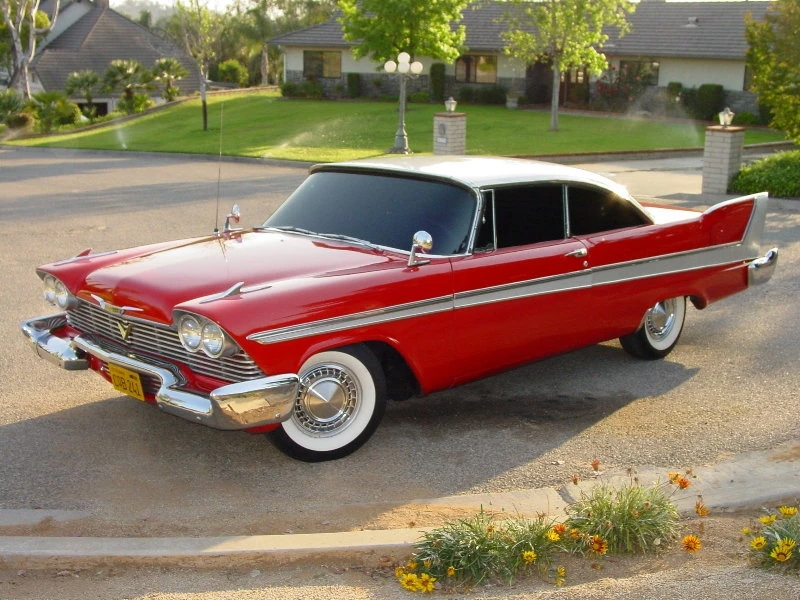
The Plymouth Fury itself is quite stunning, it’s easy to see why Arnie became so obsessed - the supernatural aside. Plymouth went through a whole ordeal when making the Fury, resizing it back and forth over the years, alternating from a full-size car to a mid-size car. The Fury was a sub-series of the Plymouth Belvedere from 1956 through to 1958. The Fury featured a long and wide body with large vertical tailfins protruding from the rear.
The Fury was fitted with a V8 engine with twin four-barrel carburettors, and in 1958, the optional engine named the ‘Golden Commando’ was introduced. The Golden Commando was a big block 350 cu engine (5.7L) with two four-barrel carburettors producing 305hp, with a 315hp fuel injection option available.
Shaun of the Dead 2004 – 1996 Renault Megane RT and 1986 Jaguar Sovereign V12
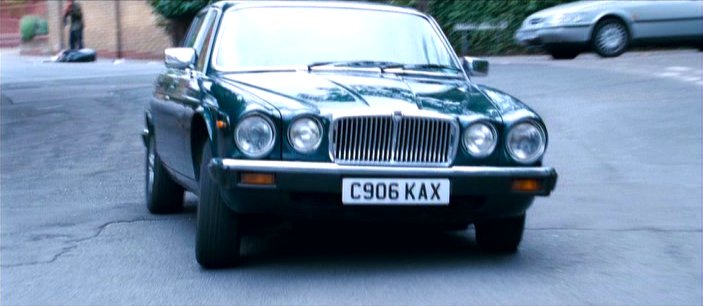
Shaun of the Dead is a witty zombie comedy film directed by Edgar Wright and written by Wright and Simon Pegg. Simon Pegg stars as the film’s protagonist, Shaun, a downtrodden businessman stuck in a mundane routine who is the last to know about the zombie apocalypse that surrounds him. Nick Frost stars as Shaun’s crude, layabout best friend, Ed, who lives on Shaun’s sofa. Their on-screen friendship is believable as the two actors are close friends in real life. Shaun of the Dead explores how the average British person would react to and survive an apocalypse. The film was inspired by ideas Pegg and Wright used for their sitcom ‘Spaced’, in which one of the episodes Pegg’s character hallucinates a zombie apocalypse. Pegg would also go on to say that he wondered what a zombie apocalypse would look like if it happened to him, and being British, he wouldn’t have access to firearms like traditional American zombie characters do. The film pays homage and makes many references to other zombie media such as ‘Night of the Living Dead’ and ‘Dawn of the Dead’, showing respect to the genre while poking fun at its tropes.
Despite the far-fetched scenarios in the film, it remains relatable to British audiences, which is why it is no surprise that the film was an instant hit, grossing 38.7 million worldwide on a budget of $6.1 million. Shaun of the Dead received two nominations at the British Academy Film Awards.
In the beginning of the film, Shaun and Ed drive their other roommate’s car, a 1996 Renault Megane RT, a particularly unexciting and mundane car that reflects their current lifestyles, that are shaken up by the zombie uprising. Their lives aren’t the only thing that’s shaken up in the apocalypse, as Ed crashes the dreary car at the first opportunity when he gets the idea of driving Shaun’s stepdad’s Jaguar. The Renault meets an untimely end, but is replaced by something much more luxurious and frankly, interesting – a 1986 Jaguar Sovereign V12.
The Jaguar Sovereign was originally introduced as a luxury variant within the Jaguar XJ series lineup. The 1986 model belongs to the Series III (1979–1992) of the XJ cars, known for its sleeker design. The Series III Jaguars came with redesigned bumpers, twin fuel tanks and improved aerodynamics, though the general style kept Jaguar’s classic long and sleek silhouette. The Sovereign had an upgraded interior featuring additional leather and wood veneer finishes. While it doesn’t sound like the typical zombie survival machine, it was powerful for its time and was comfortable to drive.
Under the hood, the Sovereign V12 featured a 5.3-liter V12 engine, putting out around 295hp. This engine made it capable of reaching 0-60 mph in just under 8 seconds, which was quite impressive for a car with such a heavy build, weighing around 1850kg. The V12 engine of the Sovereign has been known to be difficult to maintain, which is probably not what you want when amidst a horde of blood-thirsty zombies.
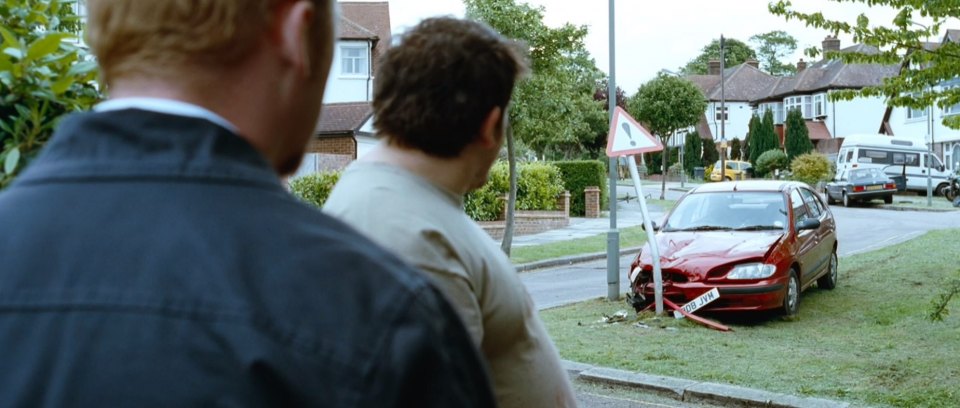
"Pranged it..."
The Car 1977 – 1971 Lincoln Continental MIII
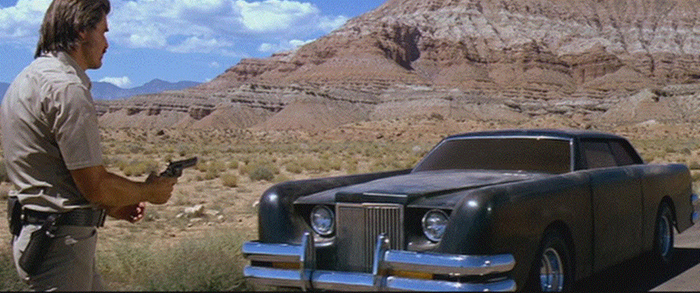
The Car, directed by Elliot Silverstein, is a mystery/horror/thriller with a lot of car action, as you would expect from a film creatively named, ‘The Car’. The film follows a troubled band of sheriffs in the rural and desert landscaped Thomas County, California, as they must set aside their personal problems to investigate a number of mysterious deaths, all seemingly related to a driver in a black sedan running down the victims. The car in question is seemingly possessed, as it is noticed that there is no driver behind the wheel during the killing spree. The demonic car appears indestructible and terrorises the small community as the hopeless sheriffs do their best to fight back.
Inspired by Jaws and numerous ‘road movies’ of the 1970s, including Steven Spielberg's thriller Duel (1971) and Roger Corman's Death Race 2000 (1975), The Car met some criticism and was not considered a success by some critics. It did, however, gain enough attention to remain in the conversation over the years, with its influence seen in other media, and is often looked back on fondly. Viewers recognise the cheesy and absurd premise, but also see the merits in its character setup and cinematography. Many people have said that the film scared them as a child, so maybe that has something to do with it.
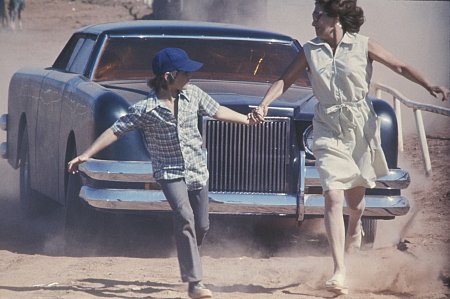
The car that takes centre stage is never officially identified in the film, but it is, in fact a Lincoln Continental MIII, and a heavily modified one at that. The car in the film was painted matte black, had a custom front grille, a lowered roof, longer side fenders and tinted windows as to make the car more threatening and demonic. The front grille was made in an attempt to resemble a face. The creator of this car was Hollywood car designer George Barris, also known for his work on the 1966 Batmobile for the Batman TV series and film. It may sound difficult to make a car appear scary, but for what they had available at the time, and combined with the cinematography, I’d say they did a pretty good job. The indestructible, unstoppable and blood-lusted nature of the car and the absolutely horrifying horn it wails in the distance to announce its presence also help cement the feeling of dread it emanates. It’s a shame that almost every car they used on set ended up destroyed over the course of production.
There are many more cars in our favourite Halloween flicks that we haven’t looked over, and choosing what cars made the cut was not easy. Maybe next year we will continue this list and explore more of cinema’s creepy cars!







